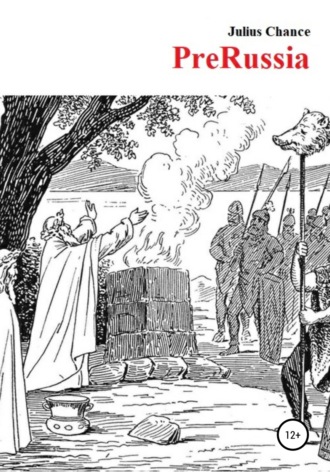
Julius Chance
PreRussia
The Russian Khaganate
The Ioakim chronicle confirms that Rurik and his two brothers were Slavs and grandsons of the previous Russian Grand Duke of Novgorod Gostomysl (in the "Tale of Bygone Years" Gostomysl is not mentioned). Excerpts from it were presented by the historian Tatishchev in 1748 according to the manuscript of Joachim, the first bishop of Novgorod, appointed after the baptism of Russia. He died in 1030. Scientists have long been skeptical of the Ioakimov Chronicle as of an invention of Tatishchev, since its original was lost.
But suddenly several facts from this chronicle were confirmed by archaeological excavations. In addition, Gostomysl was found recorded by the first prince in two Novgorod chronicles. Moreover, a certain Prince Gostomysl is also mentioned in Western chronicles. This was the name of the leader of the West Slavic tribe of the Veneds, who, according to some sources, died in 844 in a battle against King Louis II of Germany, and according to others, was able to escape to Novgorod, where he was "seated" (chosen) to reign. Today, historians no longer consider it "bad form" to refer to the Joachim Chronicle, but with reservations such as "perhaps" and "probably".
The "Legend of Slovene and Rus" by an unknown author also echoes the Joachim Chronicle, which some historians consider to be rather a recorded legend than a real story. According to these two works, the state of Russia was founded by the sons of Prince Scythian. The brothers Sloven and Rus came to Lake Ilmen and built two cities there: the first – the "great city" Slovensk in 2409 BC (later renamed to Veliky Novgorod, as some believe), the second – the city of Rus (now Staraya Russa, meaning “Old Rus”). From Sloven power passed to one of his sons, Vandal. It was he who actually created the so-called Russian Kaganate, "having conquered many lands and peoples on the coast of the sea." When Prince Burevoy, the grandson of a Vandal, ruled the state, the overseas invaders—Varangians (Vikings) coveted the wealth of the lands under his control. The prince resisted the invasion, but was defeated near the Kumeni River (now Kyumijoki, Finland) and with the rest of the squad took refuge in the city of Byarmy where he died soon after. The Varangians imposed heavy tribute on the conquered lands.
But Burevoy’s son Gostomysl (“seated” on the throne in Novgorod) came to his father's aid. He managed to gather a strong army, expel the Varangians , stop paying tribute and re-unite the peoples into a single state. Gostomysl made peace deal with the Varangians (Vikings), and since then "there has been silence all over these lands."
Slavic island of Ruyan
Further, the Joachim Chronicle and the "Legend of Slovene and Rus" diverge somewhat. According to the legend, Gostomysl had two sons, but both of them did not survive their father. Therefore, Gostomysl had no one to transfer power to. Civil strife was brewing. Then, just before his death (in 844), the prince ordered to send envoys "across the sea to the land of Prussia" so that they would ask for a ruler from the family of Caesar Augustus. And so it was done. Rurik was invited. Note that Gostomysl sends an ambassadors to Prussia for some reason not by land, but by sea. The legend is largely consonant with the "Lomonosov theory", since Rurik was invited from somewhere in Prussia (although the Vistula and Dvina rivers are not mentioned), albeit Rurik is not the grandson of Gostomysl here.
By the Joachim chronicle, Gostomysl had four sons and three daughters, but all his sons either died in the war or of illness, and all the daughters were married to neighboring princes. One his daughters, Umila was married to one of the West Slavic princes from the island of Rugen (now in Germany, in old slavic – “Rujan”) and gave birth to three sons. Rurik, the eldest of them, was invited by Gostomysl to the Grand duchy in Novgorod in order to observe dynastic succession, the legality of power and prevent civil strife. Rurik came along with his brothers. The chronicle in the main also does not contradict the "Lomonosov’s theory", except that the grandson Rurik was invited not from the place of residence of the Rosses near the Rus River between the Dvina and the Vistula in Prussia, but from the then Slavic island of Rujan (Rugen).
The Rugs (Rujans in slavic) are often mentioned in foreign chronicles and the island Rugen is located just next to Prussia. At that time the island was inhabited by militant pagan Slavs who worshipped their gods in the Arkone temple in the city of the same name. Thus it becomes clear why Gostomysl sent ambassadors to Prussia "across the sea" according to the Joachim Chronicle. He probably sent them to Rugen.
Here is how the early medieval chroniclers described the Rujan Slavs: "… these are cruel people that live in the heart of the sea and are overly devoted to idolatry. They excel among all Slavic tribes; have a king and a famous sanctuary. (…) completely neglecting the benefits of agriculture, they always ready to make attacks on the sea, laying their only hope and all their wealth on ships. That is, the Rujans led the real Varangians’ (Vikings’) way of life.
The Rujans had a large fleet and extensive trade relations with Scandinavia and the Baltic States. They carried out frequent military attacks. For example, some provinces of Denmark before the era of King Valdemar I paid tribute to the Rujans. At one time their kingdom became so powerful that it controlled almost the entire Baltic Sea, which then was called the Sea of Rugs (Rujans) for quite a long time.
The island was the main pagan worship place of the Western Slavs. Back in the XI century, pilgrims from the distant and already seemingly Christian Czech Republic came to its main four-headed shrine – the idol of Svyatovit. The popularity of the four–faced idols was not limited only to Western Slavs – archaeologists found such idols in Eastern Slavic countries – in Ukraine, Russia and Bulgaria.
The Slavs of the island defended their independence and their faith for a very long time – until 1168, when they were defeated by the Danish king. The temple of Arkon was destroyed. According to the Danish chronicles, King Rujana – Jaromir became a vassal of the Danish king, and the island became part of the bishopric of Roskilde. The Rujans were converted to Christianity.
However, already in 1234, the Rujans not only freed themselves from Danish rule, but soon captured part of the nearby coast – Western Pomerania (now part of Germany), founding the city now known as Stralsund. Further, the Rujans participated in numerous wars. In the end they lost their independence and, being part of various German state formations over the next few centuries, gradually became culturally Germans. The Rujan Slavic dialect was still heard in some places on the island until the XVI century.
It is assumed that the island of Buyan, from Pushkin's famous fairy tale, is actually Rujan. Today lighthouses are installed on the cape of the island where the temple city of Arkon once stood. The photo shows the remains of the Slavic fortress of Arkona. The rampart that used to protect the fortress is still clearly visible. There is an exhibition of Arcona Fortress artifacts in the tower.

"The map of the placement of the West Slavic tribal unions of the Bodrichs (Obodrits) and Lyutichs (Velets) in the VIII—X centuries", by Vladislav Matveev (p.n. Trevbus) taken from the website https://commons.wikimedia.org under CC license.
As we see, the chronicle "The Tale of Bygone Years", the Joachim Chronicle and the "Legend of Slovene and Rus" overlap with each other. According to each of them, Russia as a state entity (at least at the level of individual principalities) was actually formed centuries before the arrival of Rurik in 862. Also, all three sources agree that a certain Rurik was invited from across the sea. By origin Rurik is either a Varangian (Viking) or a Prussian, or a Western Slav.
If we suppose that Rurik came from the island of Rujan, then the inconsistencies between the three sources are significantly smoothed out since in this case Rurik is at the same time a Varangian from across the sea and a Slav living near Prussia. Some historians are inclined to this version. In this scenario Eastern Russia simply invited a Varangian (Viking) ruler from Western Russia. Understandably he became "legitimate" in both parts of Russia and therefore was able to unite the Eastern Slavic principalities with some Western ones into a single state.
The visit of the artist Ilya Glazunov to East Germany
Before the collapse of the Soviet Union, the Russian artist Ilya Glazunov was suddenly irresistibly drawn to visit the island of Rujan during his stay in the Western German Republic (under the protectorate of the USSR). At that time the students of the University of Berlin were conducting archaeological excavations there. He learned from them that a few days ago they had dug up a Slavic wooden boat of the IX century. Then Glazunov asked the archaeologists what other artifacts they found and received a somewhat irritated response from a Teuton which was forever etched into his memory: “Everything to magma here is Slavic!.."
In Berlin Glazunov told about this to the deputy professor Herman. "I can tell you that in the Western Germany we have a huge warehouse full of Slavic artifacts and the ancient books written in Old Slavonic. After the end of the [Second World] War we took a lot of things to this vault and so far no one has been digging in it. <…> None of your Soviet or our scientists showed any interest in this", the professor replied. Glazunov wrote about his trip in his book "Russia Crucified".4
Other West Slavic tribes
It is worth noticing that there was also another Slavic union of several tribes called the Obodrits (Bodrichs) living not far from both the island of Rujan (Rugen) and Prussia on the mainland.5

"The map of the location of the West Slavic tribal unions of the Bodrichs (Obodrites) and Lutiches (Velets) in the 8th-10th centuries" by Vladislav Matveev (under the pseudonym Trevbus) taken from the site https://commons.wikimedia.org under the CC License.
In the 16th century an Austrian baron Sigismund von Herberstein, the ambassador to Moscow, wrote a book about Russia. He outlined the then generally accepted history of the emergence of the Russian state in medieval Europe. According to it the Varangians came from the Vagria region in northern Germany. Then it was inhabited by the union of Slavic tribes of the Obodrits (Bodrichs). The center of all Vagria was Stargard (Stargrad). After the capture by the Germans it now bears the name Oldenburg, which means the same thing in translation – the Old Town, that is Stargrad.
And the capital of the tribe of the Obodrites in Vagria was Veligrad (Wiligrad, Lat. Magnopolis). It is mentioned under the year 965 in the work of the Arab author Ibrahim Ibn Yaqub 6 (at the end of the X century captured by the Germans and renamed to Mecklenburg). In the east, the Obodrites had founded Novgorod even earlier. When the inhabitants of Novgorod had discord they naturally turned to their ancestral homeland with a request to send them an authoritative prince. So Rurik and his brothers arrived in Novgorod to reign.
The Obodrites played a significant role in the history of Germany and Prussia taking part in many of their foreign and internecine wars. In the end the fate of the Rujans (Rugs) befell them – they gradually became culturally like Germans lost their independence, were converted to Catholicism and forgot their native language.
Slavic Prussia
Now let have a closer look at the Prussians. As proved by Lomonosov, in ancient times the Slavs formed a single Russian-Prussian tribe. When the Prussians separated into a separate ethnic group and became "independent", other Slavic tribes continued to live right next to them. Among them were those who continued to consider themselves Slavs – not only the Rujans and Obodrites already mentioned above, but also others, shown in the map (colored).

The map of the "Principality of late Kievan Rus" by SeikoEn, processed by the user Das steinerne Herz, taken from the Swedish site https://sv.m.wikipedia.org under the CC license.
In pagan times a significant part of "independent" Prussia was again subordinated to Russia. The regions of Prussia, which directly bordered Russia at that time were inhabited by Prussians and Jews. Since 983, after the successful campaign of Prince Vladimir Krasno Solnyshko (Vladimir Red Sun), these areas of East Prussia were again listed among the Russian possessions. Apparently not for long, since in 1037-1038, the Grand Duke of Kiev Yaroslav Mudriy (Yaroslav the Wise) made a campaign against the Yatvyags as part of a large several-year Russian offensive in the western directions and included his lands in his principality. 7
The Prussians willingly went to the service of the Russian princes. In 1215 the Prussian combat detachment acted on the side of the freedom-loving Novgorod boyars’ Veche (a parliament of the nobles) in their struggle with their prince as a striking military force8. In Novgorod, one of its most ancient streets was inhabited by Prussian settlers and even bore the name “Prussian” (now Zhelyabov Street). So, the Prussians lived on the Russian soil since ancient times.






